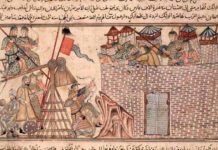The Spanish language, whilst not always being the most spoken language in the Philippines, has been an integral part of Filipino society for over 400 years.
The Spanish language arrived in the Philippines in the mid-16th century. During 333 years of Spanish rule the Philippines failed to embrace the language in a similar manner to Latin America. Nevertheless, Spanish flourished there in the early 20th century before being cast aside in favor of Tagalog and English.
The Introduction of Spanish to the Philippines
When Miguel López de Legazpi, a Spanish conquistador, landed on the island of Cebu in 1565 he brought the Spanish language with him. King Philip II (r. 1554-1598) decreed that Spanish authorities in the Philippines should to teach the natives Spanish. In practice, however, the missionaries realized that teaching all the locals Spanish would be difficult. They decided it would easier to learn the indigenous languages of the Philippines and preach to the locals using their own language.
Certain Spanish words, however, were introduced. For example, the Tagalog people believed in a supreme being called Bathala. In order to avoid confusion between Bathala and the Christian God, the missionaries introduced the Spanish word Dios, or “God”.
Spanish Fails to Become Widely Spoken in the Philippines
When Spanish rule of the Philippines came to an end in 1898 Spanish was the first language of around 10-15% of the population. In the countrys capital, Manila, approximately 50% of people spoke Spanish.
In 1863 Queen Isabel II (r. 1833-1868) sought the establishment of a public school system that would see at least one school for boys and girls in each town. The primary language of instruction was Spanish. Filipino academic, Guillermo Gómez Rivera, states in Statistics: Spanish Language in the Philippines that Agustin de la Cavada y Mendez de Vigo estimated that 2.8% of the population spoke Spanish in 1870—the year the study was published. It is clear that Isabel IIs insistence on Spanish being the primary language at schools had an effect on the amount of Spanish speakers given that the figure had risen to 10-15% by 1898. Had the same stringent policy been seen through in the early years of Spanish rule, the language may have been entrenched into the Filipino psyche, much like it is in Latin America.
The End of Spanish Rule in the Philippines
After the departure of the Spanish, the three unrecognized successor states—the Philippine Republic, the Republic of Negros and the Republic of Zamboanga—all adopted Spanish has their official languages.
The turn of the 20th century brought American rule over the Philippines. As a result, the English language was promoted in schools and the government opted to conduct its business in English. Nonetheless, their efforts were in vain as Spanish continued to grow. In fact, Gómez Rivera alludes to Luciano de la Rosas article entitled Aves de Rapiña, or “Birds of Prey”, in El Renacimiento when he says that a 60% of the population speak Spanish as a second language. Gómez Rivera says that would mean 70% of Filipinos spoke Spanish between the 1890 and 1940.
Spanish politician, Rafael Rodriguez-Ponga, says in Pero ¿cuántos hablan español en Filipinas? that 70% may be an exaggeration. He claims that Gómez Rivera only counted people in major cities and those who spoke different varieties of Spanish, as well as varying degrees of knowledge of the language.
The Decline of Spanish in the Philippines
Spanish had been an intrinsic part of Filipino life in the first few decades of the 20th century. The children that had been educated in Spanish as result of Isabel IIs policy had grown up and continued to speak Spanish.
English had become the primary language of instruction at schools and universities and those children that had been educated in English at the beginning of the 20th century were adults by the 1930-40s. Consequently, English became more influential in daily life.
In 1973 Spanish—which had been listed has an official language of the Philippines in all previous constitutions—lost its status as an official language. It would get it back shortly after only to lose it once again in 1987. The 1987 constitution states that Filipino (based on Tagalog) and English are co-official languages, whilst Spanish and Arabic are optional languages.
Spanish in the Philippines Today
It is nigh-on impossible to determine how many Spanish speakers there are in the Philippines because censuses do not distinguish between Spanish and Spanish-based creoles, such as Chabacano.
Some older people have a working knowledge of Spanish given the fact that it used to be a compulsory subject at university. Lawyers also have a good grasp of the language since the legal code is drafted in Spanish.
Efforts are being made to increase the use of Spanish, especially since much of the of the countrys history is written in it. Former President of the Philippines, Gloria Macapagal-Arroyo, made the study of Spanish compulsory in schools.








